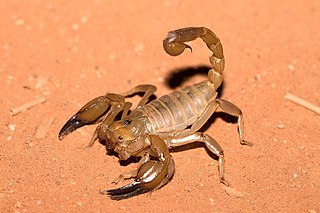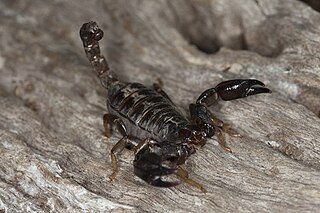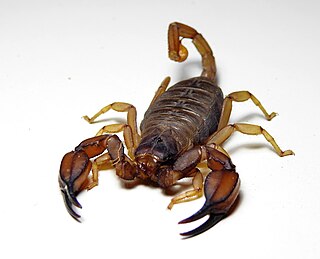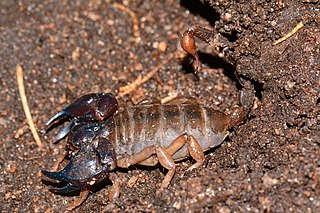William Henry Butler was an Australian naturalist and environmental consultant, best known as the presenter of the popular ABC television series In the Wild from 1976 to 1981. He was a household name as he took viewers to remote parts of Australia observing and admiring the natural environment.
The spotted mulga snake, also known commonly as Butler's black snake and Butler's snake, is a species of venomous snake in the family Elapidae. The species is endemic to Western Australia. It is a member of the genus Pseudechis, dangerously venomous snakes that can intimidate an opponent by raising the head and presenting a hood. This cobra-like threat display is supported by the ability to produce a very large amount of venom.

Urodacus is a genus of scorpion belonging to the family Urodacidae. It was described by German naturalist Wilhelm Peters in 1861. The type species is U. novaehollandiae. Its species are native to Australia, and dig burrows. The genus was placed in its own family in 2000. Before this, the group had been a subfamily Urodacinae within the family Scorpionidae.

Urodacus manicatus, commonly known as the black rock scorpion, is a species of scorpion belonging to the family Urodacidae. It is native to eastern Australia.

Urodacus elongatus, commonly known as the Flinders Range scorpion, is a species of scorpion belonging to the family Urodacidae. They are endemic to the Flinders Ranges of South Australia. They were described by L.E. Koch in 1977.

Urodacidae is a family containing two genera of scorpions, both of which are endemic to Australia. It was first described by British zoologist Reginald Innes Pocock in 1893. Formerly a subfamily (Urodacinae) of the Scorpionidae, it was later raised to family rank. Its sister taxon is the monotypic family Heteroscorpionidae, the species of which are confined to Madagascar.
Urodacus armatus, also known as the yellow sand scorpion or inland desert scorpion, is a species of scorpion in the Urodacidae family. It is native to Australia. It was first described in 1888 by British zoologist Reginald Innes Pocock.
Urodacus carinatus is a species of scorpion in the Urodacidae family. It is native to central Australia, and was first described in 1911 by British arachnologist Arthur Stanley Hirst.
Urodacus centralis is a species of scorpion in the Urodacidae family. It has a limited range in central Australia, and was first described in 1977.
Urodacus excellens is a species of scorpion in the Urodacidae family. It is endemic to Australia, and was first described in 1888 by British zoologist Reginald Innes Pocock.
Urodacus hoplurus is a species of scorpion in the Urodacidae family. It is endemic to Australia, and was first described in 1898 by British zoologist Reginald Innes Pocock.
Urodacus macrurus is a species of scorpion in the Urodacidae family. It is endemic to Australia, and was first described in 1899 by British zoologist Reginald Innes Pocock.

Urodacus planimanus is a species of scorpion in the Urodacidae family. It is endemic to Australia, and was first described in 1893 by British zoologist Reginald Innes Pocock.
Urodacus spinatus is a species of scorpion in the Urodacidae family. It is endemic to Australia, and was first described in 1902 by British zoologist Reginald Innes Pocock.
Urodacus giulianii is a species of scorpion in the Urodacidae family. It is endemic to Australia, and was first described in 1977 by L. E. Koch.
Urodacus lowei is a species of scorpion in the Urodacidae family. It is endemic to Australia, and was first described in 1977 by L. E. Koch.
Urodacus megamastigus is a species of scorpion in the Urodacidae family. It is endemic to Australia, and was first described in 1977 by L. E. Koch.
Urodacus similis is a species of scorpion in the Urodacidae family. It is endemic to Australia, and was first described in 1977 by L. E. Koch.

Urodacus novaehollandiae, also known as the coastal burrowing scorpion or black sand scorpion, is a species of scorpion in the Urodacidae family. It is endemic to Australia, and was first described in 1861 by German naturaliat Wilhelm Peters.
Urodacus varians is a species of scorpion in the Urodacidae family. It is endemic to Australia, and was first described in 1963 by Australian paleontologist and Western Australian Museum curator Ludwig Glauert.




